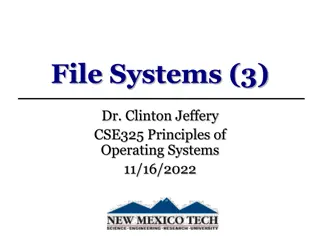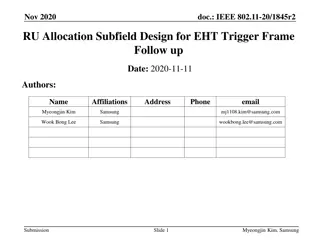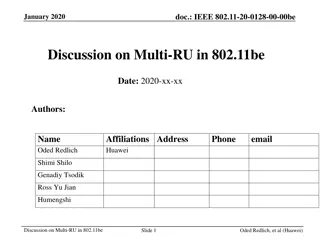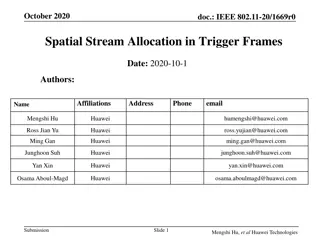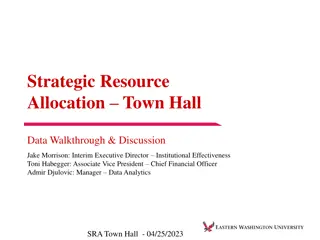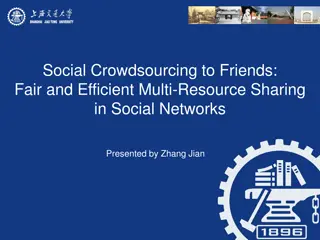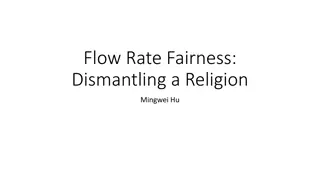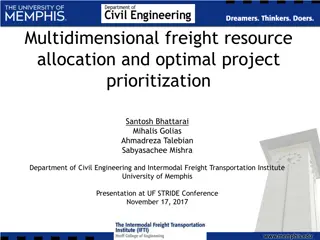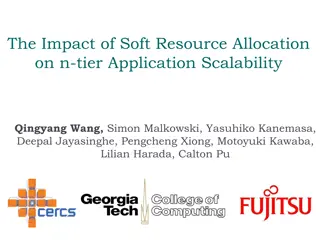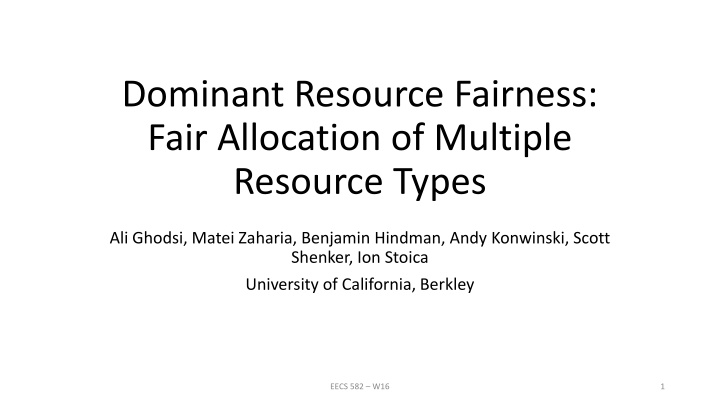
Fair Allocation of Multiple Resource Types
In the world of dominant resource fairness, understanding fair sharing and the properties of max-min fairness is crucial. Discover why max-min fairness is not always sufficient for job scheduling in datacenters, especially when considering heterogeneous resource demands. Explore the importance and implications of fair allocation in various scenarios like CPU-intensive tasks, memory-intensive tasks, and more.
Download Presentation

Please find below an Image/Link to download the presentation.
The content on the website is provided AS IS for your information and personal use only. It may not be sold, licensed, or shared on other websites without obtaining consent from the author. If you encounter any issues during the download, it is possible that the publisher has removed the file from their server.
You are allowed to download the files provided on this website for personal or commercial use, subject to the condition that they are used lawfully. All files are the property of their respective owners.
The content on the website is provided AS IS for your information and personal use only. It may not be sold, licensed, or shared on other websites without obtaining consent from the author.
E N D
Presentation Transcript
Dominant Resource Fairness: Fair Allocation of Multiple Resource Types Ali Ghodsi, Matei Zaharia, Benjamin Hindman, Andy Konwinski, Scott Shenker, Ion Stoica University of California, Berkley EECS 582 W16 1
Outlines Introduction Motivation Dominant Resource Fairness (DRF) Experiment result Conclusion 2 EECS 582 W16
What is fair sharing? n users want to share a resource (e.g. CPU) - Solution: Allocate each 1/n of the shared resource Generalized by max-min fairness - Handles if a user wants less than its fair share - E.g. user 1 wants no more than 20% Generalized by weighted max-min fairness - Give weights to users according to importance - User 1 gets weight 1, user 2 weight 2 EECS 582 W16 3
Properties of max-min fairness Share incentive Each user can get at least 1/n of the resource But will get less if her demand is less Strategy proof Users are not better off by asking for more than they need Users have no reason to lie EECS 582 W16 4
Why use max-min fairness? Desirable properties of max min fairness Isolation policy: A user gets her fair share irrespective of the demands of other users Flexibility separates mechanism from policy: Proportional sharing, priority, reservation,... Many schedulers use max min fairness Datacenters: Hadoop s fair sched, capacity, Quincy OS: rr, prop sharing, lottery, linux cfs, ... Networking: wfq, wf2q, sfq, drr, csfq, ... EECS 582 W16 5
Outlines Introduction Motivation Dominant Resource Fairness (DRF) Experiment result Conclusion EECS 582 W16 6
Why is max-min fairness not enough? Job scheduling in datacenters is not only about CPUs Jobs consume CPU, memory, disk, and I/O EECS 582 W16 7
Heterogeneous Resource Demands Some tasks are CPU intensive Some tasks are memory intensive Most task need ~ <2 CPU, 2 GB RAM> 2000 node Hadoop Cluster at Facebook (Oct 2010) EECS 582 W16 8
Heterogeneous Resource Demands EECS 582 W16 9
Motivation Figure 1 shows that though the majority of tasks are CPU-heavy, there exist tasks that are memory heavy as well, especially for reduce operations. Figure 2 shows that most of the tasks either underutilize or overutilize some of their slot resources. EECS 582 W16 10
Important Allocation Properties 1. Sharing incentive: Each user should be better off sharing the cluster, than exclusively using her own partition of the cluster. Every user should get 1/n of at least one resource. 2. Strategy-proofness: Users should not be able to benefit by lying about their resource demands. This provides incentive compatibility, as a user cannot improve her allocation by lying. EECS 582 W16 11
Important Allocation Properties 3. Envy-freeness: A user should not prefer the allocation of another user. 4. Pareto efficiency: It should not be possible to increase the allocation of a user without decreasing the allocation of at least another user. EECS 582 W16 12
Problem Definition How to fairly share multiple resources when users have heterogeneous demand on them? EECS 582 W16 15
An Example of Multiple Resource Sharing ---Example Total Resource: <9CPU, 18GB> User A wants User B wants <1CPU, 4GB> per tasks <3CPU, 1GB> per tasks EECS 582 W16 16
A Natural Approach Asset Fairness Asset Fairness Aims to equalize the aggregate resources allocated to each user Total resources <9CPU, 18GB> CPU ~ 2$ 1GB ~ 1$ User 1 wants <1CPU, 4GB> ~ 6$/tasks User 2 wants <3CPU, 1GB> ~ 7$/tasks Solution Find max(x,y) such that 6x = 7y x=2.52, y=2.16 1 gets <2.5CPU, 10.1GB> 2 gets <6.5CPU, 2.2GB> EECS 582 W16 17
A Natural Approach Asset Fairness Drawback of Asset Fairness Violates the sharing incentive property Counter Example Total resources <30CPU, 30GB> User 1 wants <1,3> User 2 wants <1,1> Solution: User 1 gets <6, 18> ~24/60 User 2 gets <12,12> ~24/60 User A gets less than half of both resources! EECS 582 W16 18
Dominant Resource Fairness - DRF Allocation policy for multiple resource Meets all four of the required policy: Sharing incentive Strategy-proofness Envy-freeness Pareto efficiency EECS 582 W16 19
Dominant Resource Fairness - DRF Dominant Resource: The resource that a user has the biggest share of Example: Total resources: <9CPU, 18GB> User 1 s allocation: <3CPU, 4GB> Dominant resource is memory for 3/9>4/18 Dominant Share: The fraction of the dominant share a user is allocated User 1 s dominant share is 33% (1/3) EECS 582 W16 20
Dominant Resource Fairness - DRF Apply max-min fairness to dominant shares Equalize the dominant share of the users Solution to the example Total <9CPU, 18GB> User 1 <1CPU,4GB> User 2<3CPU,1GB> max(x,y) (Maximize allocations) such that 2/9x = 3/9y (equalize dominant shares) Solution: User 1<3CPU, 12GB>, User 2<6CPU, 3GB> EECS 582 W16 21
Alternative Fair Allocation Policy: CEEI Economist s way to fairly divide resources Competitive Equilibrium from Equal Incomes: Give each user 1/n of every resource initially let them trades their resources with other users in a perfectly competitive market Solution given by Nash barging solution Nash barging solution EECS 582 W16 24
Alternative Fair Allocation Policy: CEEI Market Clearance Drawback : Violate strategy proofness User can cheat by claiming more than he needs to have more tasks allocated EECS 582 W16 25
Comparison Between Three Allocation EECS 582 W16 26
Comparison Between Three Allocation DRF is the only one satisfying four required properties Resource monotonicity is not possible to achieve when other properties are achieved EECS 582 W16 27
Experiment Result Experiment: DRF vs. Alternative Allocation Policies 48 node Mesos cluster on EC2 instances with 8CPU cores and 7GB RAM each (1GB for OS). Two users: User 1 <1CPU, 0.5GB> User 2 <2CPU, 2GB> Compared with: Slot-based fair scheduling (a common policy in current system, e.g. Hadoop Fair Scheduler) Max-min fair sharing for CPU resource only EECS 582 W16 28
Experiment Result EECS 582 W16 29
Conclusion DRF provides provides multiple multiple resource resource fairness fairness in the presence of heterogeneous demand First generalization generalization of max min fairness fairness to multiple resources DRF satisfies all of the desired properties of fair allocation except for resource monotonicity DRF performs better than current approaches. EECS 582 W16 32
Acknowledgement Some of our slides are borrowed from their presentation in NSDI in 2011 EECS 582 W16 33



